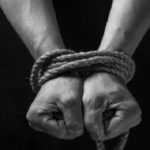 Movies and TV
Movies and TV  Movies and TV
Movies and TV  Health
Health 10 Miraculous Advances Toward Curing Incurable Diseases
 Miscellaneous
Miscellaneous 10 Undeniable Signs That People’s Views of Mushrooms Are Changing
 Animals
Animals 10 Strange Attempts to Smuggle Animals
 Travel
Travel 10 Natural Rock Formations That Will Make You Do a Double Take
 Movies and TV
Movies and TV 10 Actors Hidden in Your Favorite Movies
 Our World
Our World 10 Science Facts That Will Change How You Look at the World
 Pop Culture
Pop Culture 10 Incredible Female Comic Book Artists
 Crime
Crime 10 Terrifying Serial Killers from Centuries Ago
 Technology
Technology 10 Hilariously Over-Engineered Solutions to Simple Problems
 Movies and TV
Movies and TV 10 Movie Adaptions That Brought Popular Songs to Life
 Health
Health 10 Miraculous Advances Toward Curing Incurable Diseases
 Miscellaneous
Miscellaneous 10 Undeniable Signs That People’s Views of Mushrooms Are Changing
Who's Behind Listverse?

Jamie Frater
Head Editor
Jamie founded Listverse due to an insatiable desire to share fascinating, obscure, and bizarre facts. He has been a guest speaker on numerous national radio and television stations and is a five time published author.
More About Us Animals
Animals 10 Strange Attempts to Smuggle Animals
 Travel
Travel 10 Natural Rock Formations That Will Make You Do a Double Take
 Movies and TV
Movies and TV 10 Actors Hidden in Your Favorite Movies
 Our World
Our World 10 Science Facts That Will Change How You Look at the World
 Pop Culture
Pop Culture 10 Incredible Female Comic Book Artists
 Crime
Crime 10 Terrifying Serial Killers from Centuries Ago
 Technology
Technology 10 Hilariously Over-Engineered Solutions to Simple Problems
10 Dark Facts of the Korean War They Don’t Teach You in School
How much do you know about the Korean War? Most people have some basic information, but there’s a good reason it is remembered as “The Forgotten War.” This is because it’s one of the least talked about wars in American history. However, it lasted for three years and resulted in the death of over 34,000 American soldiers.
It was completely overshadowed by World War II and the Vietnam War—and there are a lot of dark secrets that surround this war that most people just don’t know.
Related: Top Ten Fascinating Facts About North Korea
10 20% of the Population of North Korea Died during the War
In the early 1950s, the United States dropped 635,000 tons of bombs and 32,557 tons of napalm on North Korea. It was considered an overwhelming attack that would leave North Korea with no industry or cities standing. In fact, the goal was to make North Korea a desert that didn’t allow life.
The intense bombing campaign was authorized by U.S. President Harry Truman and carried out by General Curtis Le May. According to Le May, the bombings were so severe that 20% of the population of North Korea died.
The bombs destroyed hundreds of thousands of homes and killed millions of civilians. The plan was to leave North Korea’s territory with no chance of resupplying itself, setting up industries, or growing farms—and the U.S. almost succeeded.
In addition to the physical destruction, the bombings also caused psychological damage that has lasted for generations. Today, the North Korean government still instills fear in the population with the memory of the American attacks. That has allowed the North Korean government to remain so strong after more than seven decades.[1]
9 The U.S. Was About to Nuke China and North Korea
At the outbreak of the Korean War, General Douglas MacArthur was named the commander of United Nations forces. He was a highly decorated general who had served in World War II with the highest possible achievements and honors.
He was known for his aggressive tactics and willingness to use whatever means necessary to win. In September 1950, MacArthur launched a bold offensive that pushed the North Korean army back across the 38th parallel. As the UN forces advanced, MacArthur began to consider using atomic bombs to end the war and prevent China from getting more involved.
The plan was to drop atomic bombs on China and North Korea and to deter communist governments from participating in the war. It would have changed history completely, and China might not be a major global power today. However, President Truman opposed it. He believed using atomic weapons would set a dangerous precedent, and he was unwilling to risk a full-scale war with China.
As a result, Truman relieved MacArthur of his command in April 1951. While MacArthur’s actions during the Korean War were controversial, his aggressive tactics helped to turn the tide of the war in favor of the UN forces.[2]
8 The Bombing Only Stopped When There Was Nothing Left to Destroy
One of the most brutal aspects of the war was the widespread use of bombing. Whole villages were destroyed, and civilians were often killed. And the bombing continued until there was nothing left to destroy.
The most impressive thing is that almost all North Korean buildings were destroyed. Since then, the country has struggled to rebuild its cities. The process has been slow and difficult, hampered by a lack of resources and international sanctions.[3]
7 South Korea Killed All the Suspected Communists
During the war, South Korea killed all the suspected communists. The massacre occurred after a group of North Korean soldiers crossed the 38th parallel and attacked South Korea.
The communists retreated with the entry of the U.S. into the war. But, the trauma remained. During this period in which North Korea took over South Korea, many people collaborated with the communist government as well as having been communist sympathizers.
In response, the South Korean government formed a paramilitary group composed of right-wing extremists that managed to kill as many communists as they could
The group conducted a series of mass executions, killing approximately 100,000 people in South Korea who were suspected of supporting the communist North. Most victims were innocent civilians who had no connection to the North Korean regime but who probably supported North Korean troops when they invaded South Korea.
The massacre was a pivotal moment in the Korean War, and it remains one of the most brutal episodes in recent history. By the way, the U.S. was also involved in some massacres against North Korean civilians.[4]
6 Seoul Was a Communist City for Some Months
Seoul was a communist city when it was captured by North Korea. It remained under communist control until the U.S. started bombing the North Korean forces. After a successful counterattack by United Nations forces, the city was recaptured just a few months later.
However, this left an unforgettable impression on the inhabitants of Seoul. If it had not been for the help of the United States, the entire peninsula would have been under communist control – and even Seoul would have been under Pyongyang’s control quite easily.[5]
5 The Korean War Is Not Over Yet
Many people think that the Korean War ended in 1953 with the signing of the armistice agreement. However, the war is technically not over.
The war ended in a stalemate, with no clear winner. The armistice simply put a halt to the fighting, and a peace treaty has never been signed. As a result, North and South Korea are still technically at war. And U.S. troops remain stationed in South Korea as a deterrent against further aggression from the North.
While it is unlikely that full-scale hostilities will resume, the situation on the Korean peninsula remains tense, and any small incident could spark new violence. As long as a peace treaty has not been signed, the Korean War will continue to be a part of our world.[6]
4 Frostbite Was a Big Enemy of the American Troops
For soldiers in the Korean War, frostbite was a very real threat. The temperatures in Korea during winter can drop well below freezing—and soldiers were often ill-equipped to deal with the cold weather.
The combination of bitterly cold temperatures and inadequate clothing led to numerous cases of frostbite, particularly among those who were wounded or who had to spend extended periods outdoors. In some cases, soldiers had to be evacuated from the front line due to frostbite. In others, amputation was the only way to save their lives.
In the end, 30,000 people were injured or completely disabled. Many soldiers lost fingers, toes, or even entire limbs due to the extreme cold in the Korean peninsula.[7]
3 Countries from All Continents Took Part in the Korean War
The Korean War quickly escalated into a full-scale global war involving China, the United States, and several other countries from all continents, including Australia, Belgium, Canada, Colombia, Ethiopia, France, Greece, Japan, New Zealand, Norway, the Philippines, South Africa, Thailand, Turkey, and the United Kingdom, among others.
Nevertheless, the conflict was quite bloody, and all this international support didn’t deter the communists from advancing. The United Nations lost about 40,000 soldiers during the conflict, not counting the millions of deaths in North Korea during those three years of war.[8]
2 Korean War Strengthened Kim’s Hold on Power
Kim Il-sung was the grandfather of Kim Jong-un. He used propaganda to portray himself as a heroic leader who was defending the country from the aggression of the U.S. and its allies. He ended up as the North Korean founding father based on the resentment the war generated among the North Korean population.
Everyone in North Korea lost a loved one. They lost their homes and way of life during the war, enabling a charismatic leader like Kim Il-sung to establish his own dynasty.
In addition, the war gave Kim Il-sung an excuse to purge his opponents and consolidate his control over the country.[9]
1 A Proxy War between the U.S. and the Soviet Union
In addition to being a war between South Korea and North Korea, it was also a proxy war between the United States and the Soviet Union. And this short conflict would mark the beginning of the decades-long Cold War.
The United States supported South Korea, while the Soviet Union supported North Korea. Both powers were present in the war—although the Soviet Union played a more logistical role and provided weapons to hinder the actions of the United States.
For the Soviet Union, the aim of this war was to keep the United States engaged in wars to prevent another conflict in Europe that would threaten the Soviet Union directly.[10]






![Top 10 Dark Facts About The Death Penalty [DISTURBING] Top 10 Dark Facts About The Death Penalty [DISTURBING]](https://listverse.com/wp-content/uploads/2020/06/deathpenalty-150x150.jpg)

